How to Make Bami Haeng - Egg Noodles With Wonton and BBQ Pork
To make authentic Bami Haeng, you’ll need to master three key components: egg noodles, wontons, and BBQ pork. Start by boiling yellow wheat noodles until al dente, then prepare wontons with seasoned ground pork and shrimp. Stir-fry BBQ pork slices until caramelized, and combine everything with a savory mixture of soy sauce, oyster sauce, and fish sauce. Garnish with bean sprouts and cilantro. This Thai-Chinese fusion dish holds centuries of culinary tradition worth exploring.
Key Takeaways
- Boil egg noodles until al dente, drain, and combine with stir-fried garlic, ground pork, and signature Thai sauces.
- Prepare wontons by filling wrappers with seasoned ground pork and shrimp mixture, then fold and fry until crispy.
- Stir-fry BBQ pork slices separately until caramelized, adding them to the noodles for extra flavor.
- Mix soy sauce, oyster sauce, and fish sauce to create the authentic Bami Haeng seasoning blend.
- Serve immediately with bean sprouts, cilantro garnish, and condiments like Thai chili flakes and lime wedges.
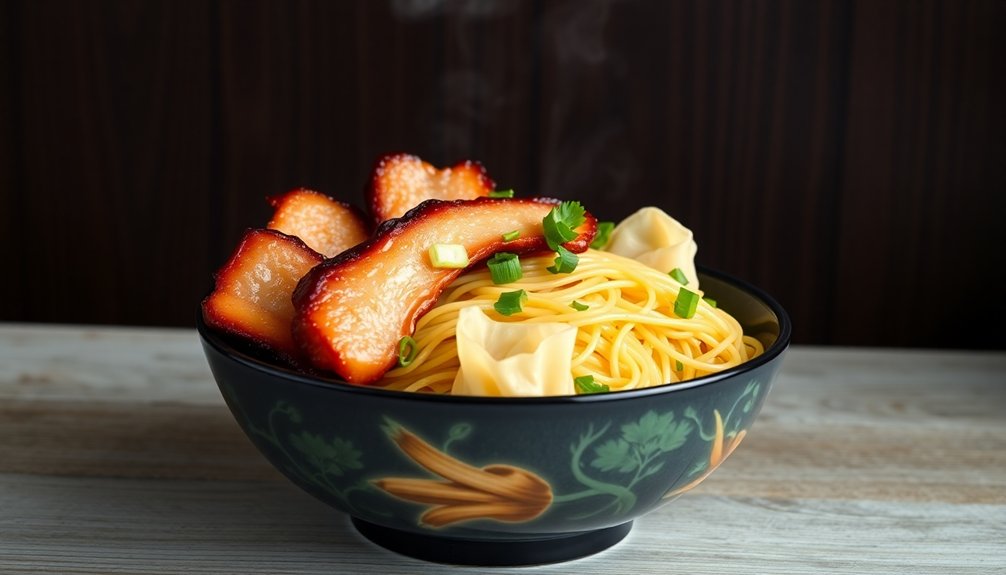
History
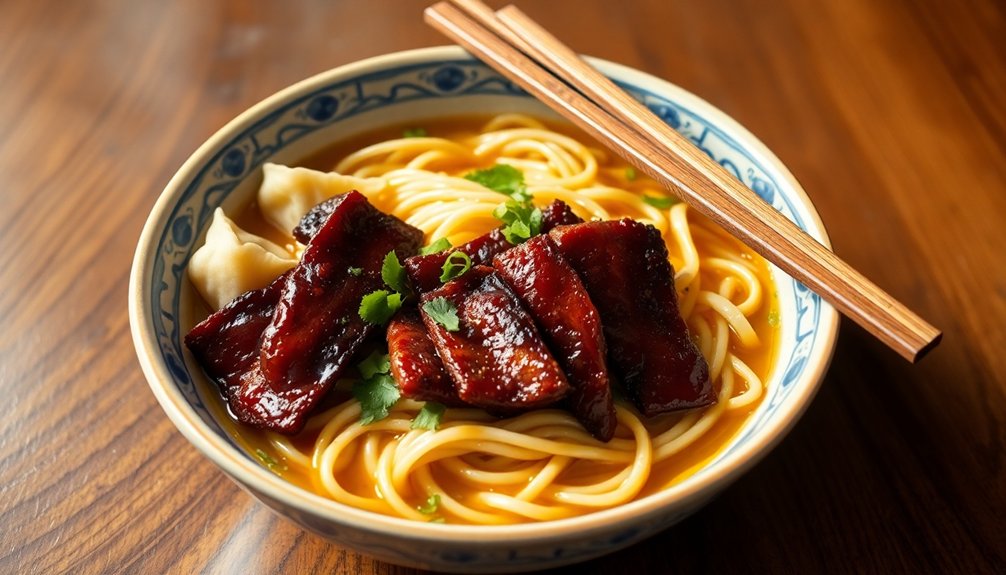
The rich heritage of Bami Haeng traces back to Chinese immigrants who settled in Thailand during the early 20th century.
These newcomers brought their culinary origins of wheat noodle-making techniques, which gradually merged with Thai flavors and ingredients.
You’ll find that regional variations emerged as the dish spread throughout Thailand.
In Bangkok, vendors often serve it with a darker soy sauce base, while northern regions prefer a lighter seasoning.
The addition of won tons became standard in central Thailand, whereas southern preparations might include extra seafood components.
Today’s Bami Haeng represents this cultural fusion, combining Chinese egg noodles with Thai-style barbecued pork and local condiments.
The dish exemplifies how immigrant food traditions have become integral to Thailand’s modern street food landscape.
Recipe
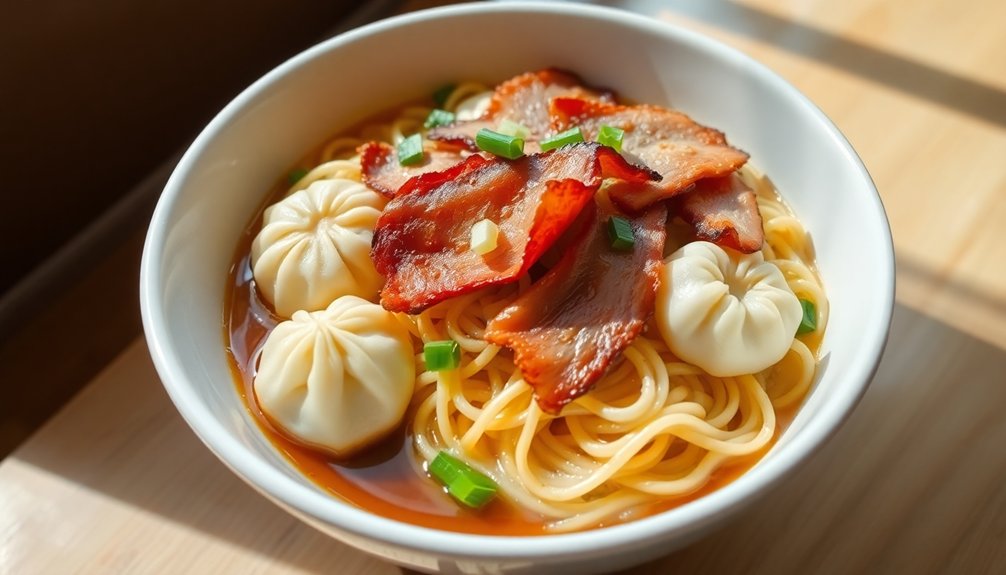
Ingredients:
- 1 lb egg noodles (yellow wheat noodles)
- 1/2 lb ground pork
- 2 cloves garlic, minced
- 1 cup bean sprouts
- 2 green onions, chopped
- 1/2 cup Chinese celery, chopped
- 1/4 cup cilantro, chopped
- 2 tablespoons soy sauce
- 1 tablespoon oyster sauce
- 1 tablespoon fish sauce
- 1 teaspoon white pepper
- 2 tablespoons vegetable oil
Instructions:
- Cook egg noodles according to package instructions until al dente. Drain and set aside.
- Heat oil in a wok or large skillet over medium-high heat.
- Add minced garlic and stir-fry until fragrant, about 30 seconds.
- Add ground pork and cook until browned, breaking up any lumps.
- Add noodles to the wok and toss with the pork.
- Add soy sauce, oyster sauce, and fish sauce. Mix well.
- Add bean sprouts, Chinese celery, and green onions. Stir-fry for 1-2 minutes.
- Season with white pepper and toss to combine.
- Transfer to serving plates and garnish with cilantro.
Cooking Steps

You’ll start by boiling the noodles until they reach the perfect tender consistency while simultaneously preparing the wonton filling and stir-frying thin slices of BBQ pork.
Next, you’ll create the signature sauce by combining soy sauce, oyster sauce, and essential seasonings until well-blended.
Finally, you’ll toss the cooked noodles with the prepared sauce, arrange the BBQ pork on top, and garnish with wontons for an authentic Bami Haeng experience.
Step 1. Boil Noodles Until Tender
Plunge the dried egg noodles into a large pot of rapidly boiling water, stirring gently to prevent clumping.
You’ll need to maintain a steady, rolling boil throughout the cooking process to guarantee even heat distribution. Test the noodles’ texture after 3-4 minutes by removing a strand and biting into it – you’re looking for an al dente consistency.
Don’t overcook the noodles, as they’ll continue to soften slightly after draining.
Once they’ve reached the desired firmness, immediately drain them in a colander and rinse under cold running water to stop the cooking process.
This boiling technique helps preserve the noodles’ characteristic springy texture and prevents them from becoming mushy.
Shake off excess water thoroughly, as any remaining moisture will dilute the sauce you’ll add later.
Step 2. Prepare Wonton Filling
Begin making the wonton filling by combining ground pork, minced shrimp, finely chopped water chestnuts, and diced scallions in a large mixing bowl.
Add grated ginger, minced garlic, soy sauce, sesame oil, white pepper, and a pinch of salt to enhance the flavors. Mix the wonton ingredients thoroughly with your hands until well-incorporated.
Test the seasoning by cooking a small portion in the microwave for 30 seconds. Adjust the flavors if needed.
Once you’re satisfied with the taste, cover the mixture and refrigerate for 30 minutes to allow the flavors to meld. This resting period also makes the filling easier to handle during the wrapping process.
When you’re ready to wrap, place 1 teaspoon of filling in the center of each wonton wrapper using proper filling techniques.
Step 3. Stir-Fry BBQ Pork Slices
Heat vegetable oil in a large wok over medium-high heat until shimmering.
Add your pre-marinated BBQ pork slices, which you’ve tenderized using the traditional Chinese velveting technique with baking soda and cornstarch marinade. Spread the meat in a single layer to guarantee even cooking.
Let the pork sear for 2-3 minutes without stirring to develop a caramelized exterior. Once you see the edges starting to brown, flip each slice and cook for another 2 minutes.
The marinade will create a glossy coating as it reduces in the hot wok. Keep stirring occasionally until the pork develops a rich, reddish-brown color and slightly crispy edges.
Remove from heat when the internal temperature reaches 145°F (63°C). Transfer to a plate and let rest for 5 minutes before slicing.
Step 4. Mix Sauce and Seasonings
While your BBQ pork rests, combine dark soy sauce, light soy sauce, and oyster sauce in a small mixing bowl. The sauce balance requires precision – use 2 tablespoons of dark soy, 1 tablespoon of light soy, and 1½ tablespoons of oyster sauce for ideal flavor. Mix thoroughly until the consistency is smooth and uniform.
- Add ½ teaspoon of white pepper powder and ¼ teaspoon of five-spice powder to enhance the aromatic profile.
- Incorporate 1 tablespoon of sesame oil to bring richness and depth to the sauce mixture.
- Test the seasoning by dipping a spoon into the sauce – it should taste savory with a hint of sweetness from the oyster sauce.
These seasoning techniques create the signature Bami Haeng flavor that’ll coat your noodles perfectly.
Step 5. Combine All Ingredients Together
Place your pre-cooked egg noodles in a large wok or skillet over medium-high heat, then pour the prepared sauce mixture evenly over them. Toss the noodles continuously for 2-3 minutes to guarantee ingredient harmony and even coating.
Add your sliced BBQ pork, blanched bean sprouts, and chopped green onions to the wok. Continue stir-frying for another 2 minutes, allowing the flavors to meld together.
Top your noodles with the crispy wontons, making sure to distribute them evenly for ideal flavor balance. Finish by garnishing with fresh cilantro leaves, crushed peanuts, and a sprinkle of white pepper.
If you’d like additional heat, serve with sliced Thai chilies on the side. Your Bami Haeng is now ready to be enjoyed while the noodles are hot and the wontons maintain their crunch.
Cooking Tips
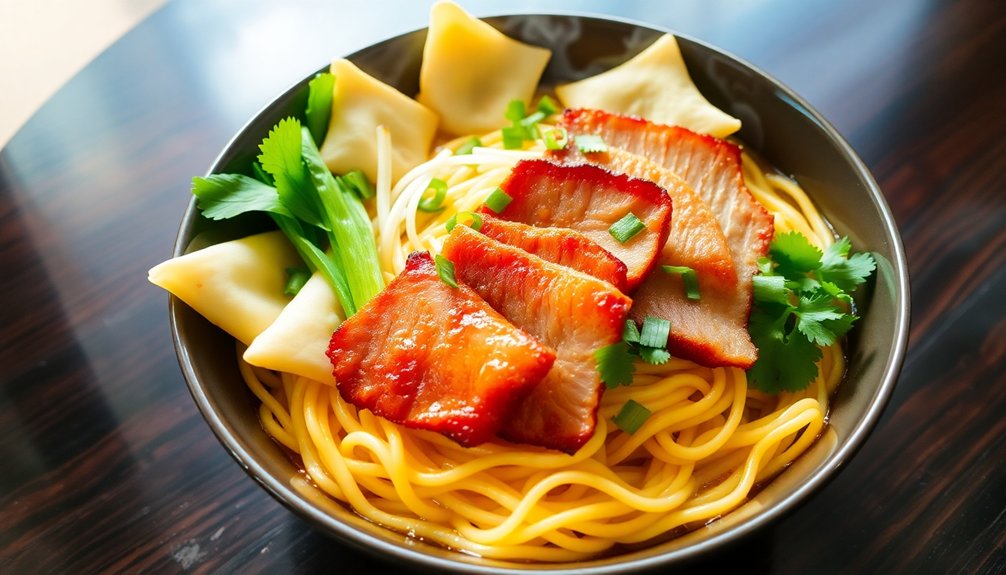
To achieve the perfect texture in bami haeng, maintaining precise cooking times and heat levels is essential. When applying proper cooking techniques, you’ll want to guarantee your wok stays at medium-high heat throughout the process.
If you’re considering ingredient substitutions, fresh egg noodles can be replaced with dried versions, though you’ll need to adjust the cooking time accordingly.
- Keep your noodles al dente by testing them frequently – they should maintain a slight bounce when bitten.
- Control moisture levels by thoroughly draining your noodles before stir-frying to prevent sogginess.
- Time your protein cooking separately – BBQ pork should be warmed last to prevent overcooking and maintain its tender texture.
Monitor your heat carefully – if ingredients start to stick, you’re cooking too hot.
Final Thoughts
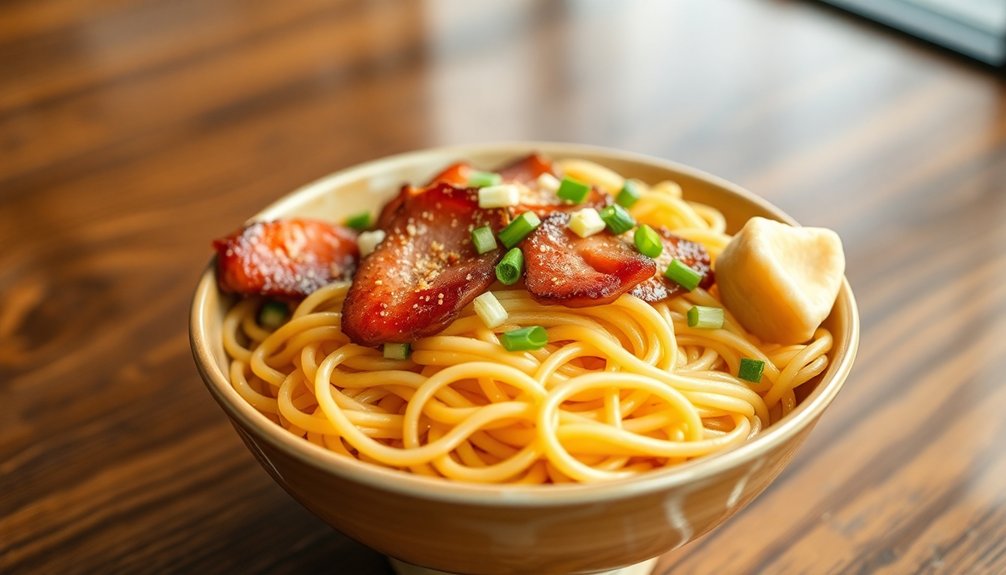
Although mastering bami haeng requires practice, you’ll find this Thai noodle dish becomes easier with each attempt. The key is understanding how each component contributes to the final flavors and textures.
You can explore recipe variations by substituting different proteins like grilled chicken or tofu for the BBQ pork, or adding bean sprouts and Chinese broccoli for extra crunch.
For serving suggestions, consider offering condiments on the side, including Thai chili flakes, white pepper, fish sauce, and lime wedges.
You’ll want to serve bami haeng immediately while the noodles are hot and the wontons are crispy. The dish works well for both casual family dinners and formal gatherings, and you can scale the portions accordingly.
Frequently Asked Questions
Can I Substitute Regular Pork With Other Meats for the BBQ Portion?
You can replace BBQ pork with chicken, turkey, or beef as alternatives. Each meat’s unique flavor profile will affect the dish differently, but they’ll still provide satisfying protein-rich results.
How Long Can Leftover Bami Haeng Be Stored in the Refrigerator?
“Waste not, want not!” You’ll get 3-4 days of leftover storage when refrigerated in an airtight container. For proper reheating, stir-fry your noodles in a hot wok until thoroughly heated.
Is There a Vegetarian Version of Bami Haeng?
You can create vegetarian bami haeng using tofu, seitan, or mushrooms as meat substitutes. Match the flavor profile with five-spice seasoning, soy sauce, and Chinese/Thai-style vegetable-based wonton fillings.
What’s the Best Type of Egg Noodles to Use for Authentic Taste?
Like golden strands of silk, fresh Chinese-style egg noodles deliver the most authentic taste. You’ll want thin, round noodles labeled “wonton noodles” or traditional varieties from Asian markets.
Can Bami Haeng Be Made Spicier Without Affecting the Traditional Flavor?
You can add Thai bird chilies or chili oil for spicy variations while maintaining flavor balance. Mix crushed red pepper or sriracha into the sauce rather than directly topping noodles.
